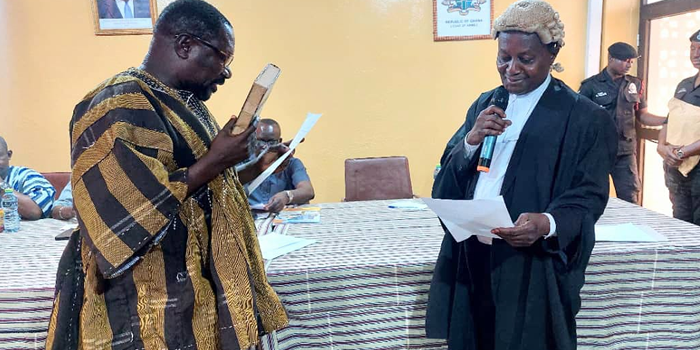

The agriculture sector is characterized by crop farming and livestock production. Despite efforts to promote the sector, production still remains at subsistence level, as there is no large plantation holding in the district. The agriculture sector employs about 90% of the labour force. The major food crops grown in the district are millet, sorghum (Guinea Corn), Maize, Cowpea and Yam. Cash crops such as cotton shea-nut and dawadawa are also found in the district. Cash crops, however, has received little attention due to market uncertainties. Economic trees such as shea, dawadawa and baobab also contribute substantially to household income in the district. The table below presents the average yield as well as the land area under cultivation each crop.
Livestock Production
The vegetation of the district promotes animal rearing. However animal rearing is at subsistence level. The major animals reared are sheep, goats, pigs and cattle. From the table above, cattle is the major livestock raised in the district. The proximity of the district to Burkina Faso and the presence of fodder could be the responsible factors. Though this could be a source of livelihood, it also results in loss of soil fertility through overgrazing. On the other hand, the dominance of Muslims in the district explains the low level pigs production, though pigs reproduce faster than other livestock.
To boost production, MOFA, under the Livestock Development Project (LDP) has supported a number of groups with a total membership of xxx in the district. The table below shows the number of groups that have received credit from MOFA to boost animal production.
Method of Farming and Farming Systems
Majority of farmers in the district still rely on traditional methods of farming using simple tools such as hoe and cutlass for cultivation. The farmers continue to rely on the rains for the cultivation of crops. The rains are however erratic, resulting in low crop yields. Thus, irrigation dams needs to be constructed to support the rains and also cater for the dry season. Alternatively, simple irrigable technology such as tube wells can be adopted.
However, few farmers use tractor services, animals traction. There is the need to promote the use of improved methods of farming to help conserve the environment and also improve production. The main farming systems in the district are mixed farming and compound farming. Bush fallowing is also practiced in some parts of the district especially the western part. Though bush fallowing is seen as a method of replenishing soil fertility, the increasing demand on land for farming is gradually limiting this system of farming and the resultant consequences on soil fertility. This implies that there is the need to promote agro-forestry, crop rotation and use of manure to replenish the soil fertility.
Extension Staff Situation of the district
In terms of extension staff, the district stands below the national standard of 1 extension staff to 1500 farmers. The district had an extension staff-farmer ratio of 1:2500 in 2005. This is not adequate to effectively serve farmers. This calls for more extension staff in the district to augment the existing staff.
Prioritized Agriculture Problems
1. Limited office and field logistics.
2. Inadequate credit facilities to farmers.
3. Inadequate field staff and office supporting staff.
4. Lack of permanent MOFA office accommodation and residential accommodation.
Service
The service sector of the district economy relates to a number of activities such as integrated marketing system, tourism, as well as restaurants commonly called chop bars. Scattered over the district are smaller/informal markets where foodstuffs and other manufactured goods are sold. In the district, there are three major markets namely, Gwollu, Fielmua and Jeffisi.
The Gwollu and Fielmua markets serve as international (cross border) markets, serving neighboring Burkina Faso. This provides ready market for goods and services. This has the potential for increasing the revenue of the District Assembly. The trading activities in the district particularly in the weekly market centres form one of the major sources of revenue to the District Assembly. In order to tap this potential, measures should be put in place to check cross border smuggling of goods. Thus the improvement of market infrastructure as well as access to markets has the potential of increasing the district’s revenue (IGF).
Date Created : 11/17/2017 4:15:16 AM












 facebook
facebook
 twitter
twitter
 Youtube
Youtube
 +233 593 831 280
+233 593 831 280 0800 430 430
0800 430 430 GPS: GE-231-4383
GPS: GE-231-4383 info@ghanadistricts.com
info@ghanadistricts.com Box GP1044, Accra, Ghana
Box GP1044, Accra, Ghana